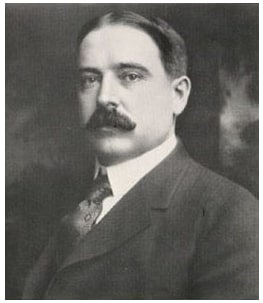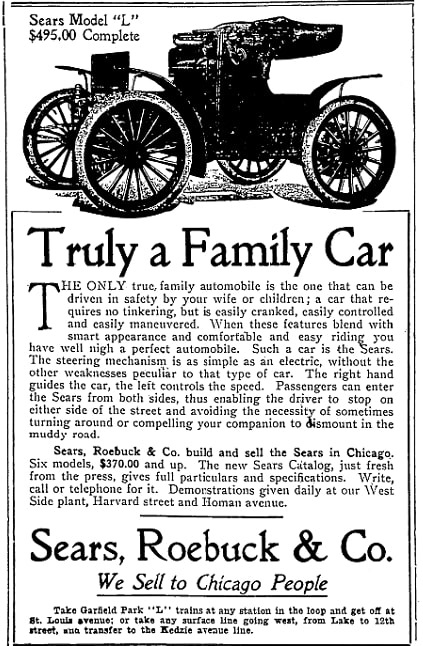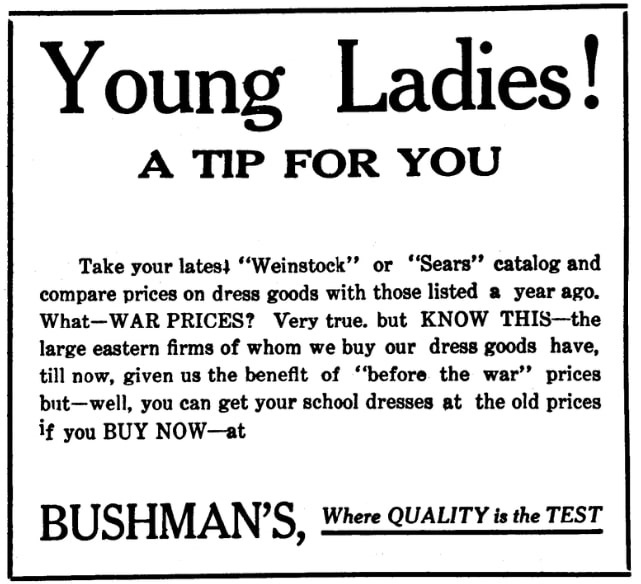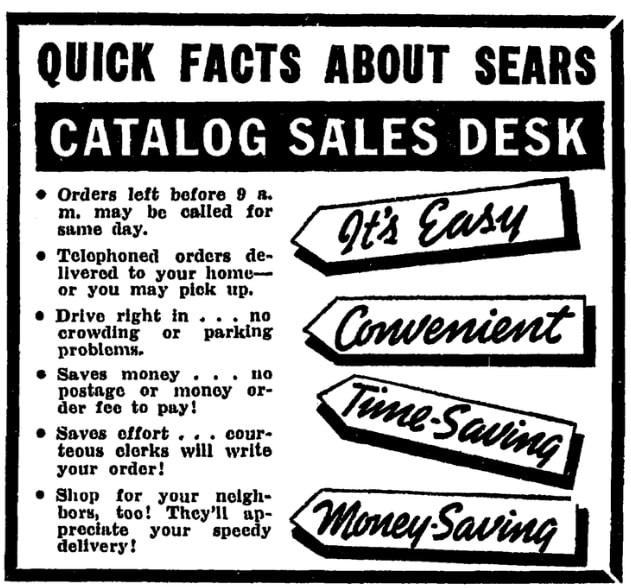Introduction: In this article, Gena Philibert-Ortega gives a fascinating glimpse into our ancestors’ lives by examining the goods available to them in the Sears catalog. Gena is a genealogist and author of the book “From the Family Kitchen.”
When you make purchases from a mail-order catalog, you are taking part in a tradition started by our late 19th century ancestors. What catalog did they buy from? They had a number of choices, including the first mail-order catalog: Montgomery Ward (1872). When we think of the catalog our American ancestors shopped, we mostly think of Sears, Roebuck, and Co.

The Sears Catalog
Sears didn’t begin as a mail-order catalog. In 1886 Richard Sears supplemented his income as a station agent by selling watches. His first catalog, featuring only watches and jewelry, was released in 1888. By 1896, Sears had a new name (Sears, Roebuck, and Company) and a new larger catalog. (1) “Richard Sears added a spring and fall catalog and enlarged the size. Specialty catalogs now appeared covering such items as bicycles, books, clothing, groceries, pianos and organs, and sewing machines.” (2)
It seems like a catalog could result in a financial windfall for a company that offered a wide variety of goods to customers who couldn’t easily travel to a store. But it took time for the catalog to become lucrative.
In 1897, some 318,000 [Sears catalogs] were sent across the Midwest. They represented a substantial financial burden for the company. So a charge was levied for the purchase of the catalog. By making a customer pay for the privilege of receiving the catalog, the company attempted to weed out those who wanted the fantasy without making any purchases. The price varied from year to year and in the early years of the twentieth century reached the substantial sum of fifty cents. Yet Sears wanted to get the book into as many hands as possible and realized the charge discouraged some potential customers. In 1904… Sears, Roebuck announced that, in the future, no charge would be made… By 1908, some 3.6 million catalogs were begin sent. Those later catalogs were offered to anyone who wanted one. Sears newspaper advertisements included coupons to send for the catalog, increasing the number of consumers having access to it. (3)
What did those early catalogs offer? The website Sears Archive lists these catalog changes:
- 1897: Sears added a color section, advertising shoes in black, red and brown. New products included cloth-bound books as cheap alternatives to hardbound books, and the Edison Graphophone Talking Machine. A Builders Hardware and Material Section appeared, selling everything a customer needed to construct a building.
- 1898: Specialty catalogs are printed including ones for photographic goods, talking machines, and mixed paints. In the general catalog a color section showed different buggies in red, green, brown, and black with gold or silver trim.
- 1899: The catalog featured color images of carpets, furniture, and china. In the photographic supplies section Sears offered “Special Lecture Outfits” giving the purchaser projection equipment, a screen, advertising posters, admission tickets, and a printing outfit – everything an entrepreneur needed to set up a theater for paying customers.
- 1903: The catalog included the commitment “Your money back if you are not satisfied.” Always looking to cater to customer needs, Sears employed translators who could “read and write all languages.” New items included barber chairs, disc graphophones, and basketballs.
- 1905: The catalog featured full color and texture wallpaper samples, and a swatch of material used in men’s suits. Following this trend, the next year he added paint samples. (4)
The Sears catalog brought all kinds of products to families making it easier to shop. Sears diversified their offerings and their catalogs reflected everything a family needed from birth to death. Yes, Sears not only sold homes and items for babies, they also offered gravestones. In the case of this 1910 newspaper advertisement, the Sears catalog included a “Sears” car.

Sears was successful and the object of comparison by other retailers. In this newspaper advertisement, young women are challenged to compare Arizona retailer Bushman’s clothing prices with the Sears catalog.

The End of an Era
The 20th century saw families eventually having the option to shop via the Sears catalog or a nearby store. Our ancestors’ families enjoyed the same convenience we are accustomed to today (except for shopping over the internet, of course). Customers could pick up their items at the store or have it delivered to their homes.

Sears continued selling merchandize (though not everything they had sold in previous generations) until 1993, when the catalog was retired. Today, although the majority of their stores have closed, there are still some Sears stores in the United States continuing their tradition of supplying families with clothing and household items.
Explore over 330 years of newspapers and historical records in GenealogyBank. Discover your family story! Start a 7-Day Free Trial
Note on the header image: Sears, Roebuck & Co.letterhead logo, 1907. Credit: Sears, Roebuck & Co.; Wikimedia Commons.
__________________
(1) “A Brief Chronology of Sears History,” Sears Archive (accessed 9 November 2022)
(2) Ibid
(3) Weil Gordon Lee. Sears Roebuck U.S.A.: The Great American Catalog Store and How It Grew. New York: Stein and Day, 1977, pp. 26-27.
(4) “History of the Sears Catalog,” Sears Archive (accessed 30 November 2022.)
Related Article:

And then they used the catalogs in their outhouses for toilet paper!